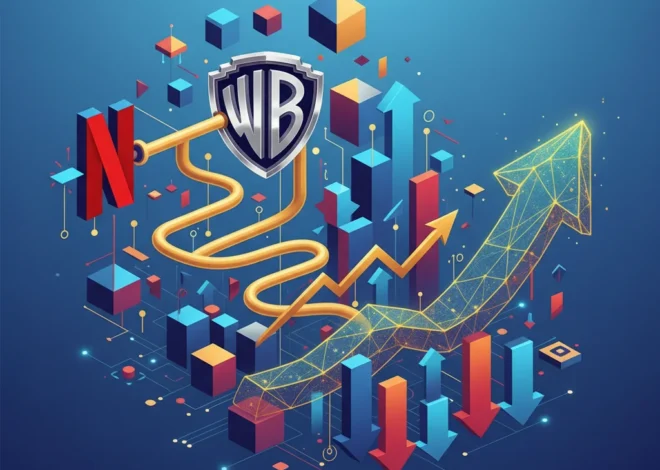
The Quiet After the Storm: Why Commodity Trading Giants Are Bracing for a New Reality
The End of an Era? Unpacking the Commodity Trading Gold Rush
For the past few years, a select group of private companies has been quietly orchestrating one of the greatest profit runs in modern financial history. Giants like Vitol, Gunvor, and Trafigura—names that rarely make household conversation but are titans of the global economy—have been riding a tidal wave of market chaos. From the supply chain snarls of the pandemic to the seismic energy shock following Russia’s invasion of Ukraine, unprecedented volatility became their golden ticket. These master traders thrive on disruption, and the world delivered it in spades.
They bought and sold oil, gas, and metals, navigating geopolitical minefields and logistical nightmares to deliver physical resources where they were needed most. In doing so, they didn’t just keep the lights on; they generated staggering, record-breaking profits that dwarfed those of many publicly traded blue-chip companies. But as any seasoned professional in finance knows, no storm lasts forever. The waves of volatility are receding, and a new, calmer, and far more challenging environment is emerging. The era of “easy money” is over, and these commodities houses are now bracing for a period of significantly “smaller rewards,” a shift that has profound implications for global markets, investing strategies, and the flow of essential resources worldwide.
How Volatility Fueled a Profit Bonanza
To understand the current shift, we must first appreciate the scale of the recent boom. Commodity trading is fundamentally a business of managing price differences across time and geography. When markets are stable, these price differences (or spreads) are narrow, and profits are modest. But when a major event—like a war or a pandemic—erupts, it shatters the equilibrium. Supply routes are severed, demand patterns become erratic, and prices swing wildly. This is volatility, and for a commodity trader, it’s the ultimate opportunity.
In the wake of the Ukraine conflict, European nations scrambled to replace Russian gas, creating massive price dislocations. Traders with the right infrastructure, knowledge, and appetite for risk were able to secure alternative supplies of liquefied natural gas (LNG) and sell them into Europe at a massive premium. According to reports, Vitol, the world’s largest independent oil trader, posted a record net profit of $15 billion in 2022, a figure that underscores the sheer scale of the opportunity. Its rivals, Trafigura and Gunvor, also saw their earnings skyrocket as they masterfully navigated the chaos.
This period saw traders taking on more risk, chartering entire fleets of vessels, and making bold bets on the direction of the market. The rewards were immense, but they were directly proportional to the unprecedented level of global disruption.
The Great Normalization: Why the Market Is Calming Down
Today, the landscape looks vastly different. The extreme price swings that defined 2022 have largely dissipated. Several factors are contributing to this “great normalization”:
- Market Adaptation: The global energy market has adapted. Europe successfully filled its gas storage facilities and diversified its supply sources. New trade routes have been established, and the initial shock of sanctions on Russia has been absorbed into market pricing.
– Economic Headwinds: Aggressive interest rate hikes by central banks worldwide, designed to tame inflation, have cooled economic activity. This dampened demand for energy and raw materials, putting a ceiling on prices. Higher interest rates also increase the cost of financing and storing physical commodities, squeezing profit margins for traders.
– Reduced Geopolitical Premiums: While geopolitical risks remain, the market is no longer pricing in the same level of acute crisis premium as it did in early 2022. Traders have become more cautious, and their appetite for taking on massive directional bets has waned in a less volatile environment.
As a result, the phenomenal profits of the last two years are beginning to normalize. Gunvor’s chief executive, Torbjörn Törnqvist, noted that the industry is “coming off a couple of extraordinary years,” and that a repeat performance is unlikely (source). This sentiment is echoed across the industry, signaling a strategic pivot from aggressive risk-taking to a more conservative, margin-focused approach.
The table below illustrates the shift from the exceptional year of 2022 to the more normalized, yet still strong, performance in 2023 for one of the major trading houses.
| Company | Metric | 2022 (Peak Volatility) | 2023 (Normalization) |
|---|---|---|---|
| Trafigura | Net Profit | $7 billion (source) | ~$1.5 billion (First Half) |
| Market Condition | Key Driver | Extreme price dislocations, supply shocks | Market adaptation, lower price volatility |
Navigating the New Terrain: Strategy in a Low-Volatility World
With the era of super-profits fading, how are these commodity titans adapting their playbooks? The focus is shifting from capturing massive windfalls to grinding out profits through operational excellence, sophisticated risk management, and technological advantage.
Firstly, there is a clear reduction in risk appetite. Traders are less willing to make the bold, leveraged bets that paid off so handsomely in 2022. Instead, they are concentrating on their core business: logistics, blending, and arbitrage. This involves finding small inefficiencies in the market and exploiting them at scale—a game of inches, not miles. This requires deep market intelligence and flawless execution, areas where established players have a significant edge.
Secondly, the role of financial technology is becoming more critical than ever. In a low-margin environment, every basis point counts. Traders are increasingly reliant on advanced data analytics, AI-powered predictive models, and sophisticated trading algorithms to identify opportunities that are invisible to the naked eye. While physical commodity trading has been slower to adopt fintech innovations compared to the stock market, this new reality is accelerating the technological arms race. Even concepts like blockchain are being explored to enhance transparency and efficiency in complex supply chains.
Finally, there’s a strategic diversification underway. As mentioned, these firms are not blind to the long-term trends shaping the global economy. They are actively investing in sectors crucial for the energy transition, including carbon trading, renewable power generation, and the metals essential for batteries and electrification. This is not just a hedge; it’s a fundamental reshaping of their business models for a future where the source of energy—and volatility—will be very different.
What This Means for the Broader Market and Investors
The cooling of the commodity markets has ripple effects across the entire financial ecosystem. For the general public and investors, this shift is a double-edged sword.
On one hand, lower and more stable commodity prices are a welcome relief. They are a key factor in bringing down headline inflation, which eases pressure on household budgets and gives central banks like the Federal Reserve more flexibility in their monetary policy. This stability can be a positive for the stock market, as it reduces input costs for a wide range of industries, from airlines to manufacturing.
On the other hand, the normalization of profits for these trading houses removes a significant, albeit opaque, source of liquidity and risk absorption from the market. These firms play a crucial role in global banking and finance, providing the capital and logistical muscle to keep physical supply chains moving smoothly. A more cautious approach from them could mean tighter credit conditions for smaller producers and more fragile supply chains in the face of the next unexpected shock.
For those involved in investing, this signals a time to re-evaluate exposure to the energy and materials sectors. The narrative is shifting from short-term geopolitical plays to long-term structural trends. Understanding the dynamics of the energy transition, the supply/demand picture for critical minerals, and the evolving strategies of these key market players will be essential for navigating the years ahead.
Conclusion: A New Chapter, Not the Final Word
The wild, chaotic, and incredibly profitable chapter for commodity trading houses is drawing to a close. The return to a more stable market environment means the end of record-shattering profits and the beginning of a more challenging operational reality. Vitol, Gunvor, Trafigura, and their peers are now recalibrating their strategies, de-risking their books, and preparing for a future defined by smaller margins and different kinds of opportunities.
However, it would be a grave error to count them out. These organizations are masters of adaptation, built to thrive at the complex intersection of economics, geopolitics, and finance. While the gold rush may be over, their fundamental role as the arteries of the global economy remains unchanged. The new landscape will test their ingenuity and discipline, but it will also reveal which of these giants are truly built to last in a world that is rapidly being reshaped by technology and the urgent need for a sustainable future.


